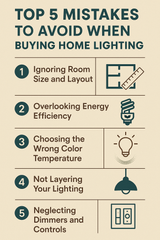How Lighting brings out the Colors of a Room
Choosing lighting wisely is crucial to interior design, because the lights used affect the way people see colors. Proper interior lighting lets you tell the difference between a navy blue and a black, and truly sets the tone of a room. Check out our quick guide to lighting design to let you optimize your illumination!
Warm Vs. Cool
The first thing to consider with interior design lighting is whether the colors
in the room are warm or cool. Warm colors will look earthy or fiery and include
red, yellow, orange or brown. Cool colors will remind people of water and
include blues, greens, and purples. The various types of designer lights work
best with certain colors and not so well with others. For example, incandescent
light is usually an orange-yellow, so it enhances warm colors, but it dulls cool
ones. Fluorescent lights are the opposite, saturating cool colors and
diminishing warm shades. As a fine middle-ground, LED lights work with just
about anything, enhancing the entire spectrum of colors depending on the type
of diode used.

A color scale (courtesy of Wikipedia) with cool coloring on the left, and warm on the right
Color Rendering Index (CRI)
The Color Rendering Index indicates how “true” a light source is, mostly in
comparison to natural sunlight. It’s essentially measure of how full the colors
are under a given light source; the index ranges from 0 to 100, and the higher
the number the better. Incandescent lights are so far the top of the heap in
this department, as they have CRIs of 100. Fluorescent lights are generally
weaker, usually holding around the range of 50, while LEDs usually work at a
minimum of 80 with
higher-end models coming in around 90+.
Lighting Location
Also important to a room’s light design is the actual placement of the light: overhead lighting tends to be the most natural of lighting, for it mimics the sun by acting from the top-down. Its effects on color will thus be similar to that of sunlight. Light from a floor or table lamp will be softer and more diffuse by comparison, as the light shines upwards and thus casts more shadows.

The last warming rays of sunlight often dramatically affect the coloring of a room
The Impact of Sunlight
As the angle and amount of sunlight changes, so will the colors in a room. The
direction in which a room faces (that is, the side with the windows) will
affect its response to the sun's natural light. For example, light in a
north-facing room will be bluish and cool. Bold, bright colors will show very
well, while pale colors will seem more muted in comparison. In a south-facing
room, sunlight will enhance both warm and cool colors.
East-facing rooms are great for warm
colors—the sunlight will be warm and yellowy in the morning and then seem
cooler later in the day. West-facing rooms get little light in the morning,
which creates shadows and makes colors look dull. By contrast, evening sunlight
in these rooms looks quite warm due to the effects of the setting sun.
The decorator, therefore, will have to know the way a given room is facing and
the time of day in which it appears darkest and gloomiest in order to choose a
light that will compensate for that deficit.
Recent Posts
-
Top 5 Mistakes to Avoid When Buying Home Lighting
Lighting plays a crucial role in shaping the ambiance, functionality, and aesthetic appeal of your h …26th Jun 2025 -
Why Lighting Is the Most Underrated Design Element in a Room
Walk into a well-designed space, and you might first notice the color of the walls, the statement fu …13th May 2025 -
How to Choose the Perfect Painting for Your Home or Office
When it comes to decorating your space, choosing the perfect painting can be a game-changer. A well- …7th Feb 2025



